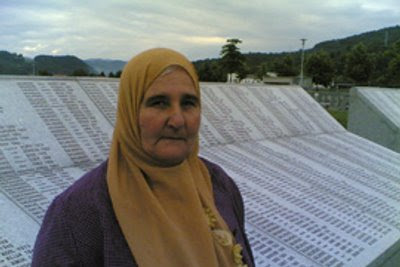RADOVAN KARADZIC COURT APPEARANCE: GAUNT AND TIRED
Updated: 07:11 PM

PHOTO: You're looking at a face of Srebrenica Genocide architect. Looking gaunt, visibly shaken and in tears, Radovan Karadzic is finally facing justice after 13 years on the run.
"You are Radovan Karadzic, aren't you?" the judge Orie, asked. "Yes, I am," he replied.
 Gaunt and visibly shaken, Karadzic listened as the Dutch UN Judge Alphons Orie read out a chilling list of atrocities contained in a lengthy 25-page indictment of war crimes, including including: genocide, complicity in genocide, crimes against humanity, extermination, violation of the customs of war, murder and the taking of hostages. Karadzic declined to enter a plea to the 11 charges against him.
Gaunt and visibly shaken, Karadzic listened as the Dutch UN Judge Alphons Orie read out a chilling list of atrocities contained in a lengthy 25-page indictment of war crimes, including including: genocide, complicity in genocide, crimes against humanity, extermination, violation of the customs of war, murder and the taking of hostages. Karadzic declined to enter a plea to the 11 charges against him.Karadzic's genocide charges will focus on his key role in the Bosnian Serb leadership which orchestrated the 1995 Srebrenica massacre of more than 8,000 Bosniaks, as well as the forcible ethnic cleansing of tens of thousands of Srebrenica civilians. "You knew or had reasons that Bosnian Serb forces under you committed these crimes," - said Judge Orie.
Other serious charges include the shelling of Sarajevo, where 12,000 civilians were killed during the 44-month siege - including 1,500 children - and the taking of UN peacekeepers hostage. "It is alleged that many thousands of civilians were killed including children and elderly," said Judge Orie.
Dutch UN Judge Orie allowed Karadzic two minutes in Court Number One to make his case. Karadzic started making excuses about his rights, not even taking time to apologize to its victims. There were "irregularities" over the way he was arrested in Belgrade 10 days ago, Karadzic complained to the judge, "In Belgrade I was arrested irregularly, for three days I was kidnapped ... my rights were not told me. I had no right to a telephone call or even an SMS," he said.
Apparently, Karadzic would have surrendered himself to the court a decade ago, had he not feared for his life. He claimed that former U.S. peace mediator Richard Holbrooke is trying to kill him: "If Holbrooke still wants my death and regrets there is no death sentence at this court, I want to know if his arm is long enough to reach me here."
Karadzic allegedly struck a deal with the US Ambasasdor Richard Holbrooke whereby if Karadzic retired from public life, the U.S. Government would not search for him. Holbrooke has in the past denied such claims. As Karadzic sought to list his grievances in detail, he was stopped short by the Judge Orie who said this was not the time or place to raise these issues and that he would have a chance to voice his complaints later.
As Karadzic was transferred to the tribunal's detention unit in The Hague on Wednesday, ICTY chief prosecutor Serge Brammertz warned his trial may not start for months. "It will be a complex trial," Brammertz said. "In order to prove these serious crimes, the prosecution will have to present a significant amount of evidence including the testimony of many witnesses."
The judge set August 29th as the date for his next appearance. Under court rules if he refuses to enter a plea, then a plea of ‘not guilty’ is entered for him.

PHOTO: Radovan Karadzic before his departure to the Hague, and during his detention at the Belgrade's War Crimes prison.


































